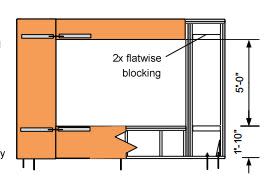smeller
Structural
- Dec 28, 2017
- 2
I recently went on a site visit for a project of mine and noticed that the contractor placed the force transfer shear wall straps, located at the corners of openings, on the inside face of the wall sheathing. Our drawings do not explicitly say which face of sheathing to place the straps aside from showing a shear wall elevation that suggests the straps are on the outside face. I am fairly new to force transfer shear walls and have only ever seen images of walls with strapping on the outside face of the sheathing, so I am not sure if this is okay or compliant with my analysis. I also cannot find any literature that suggests straps need to be on any particular face of the sheathing.
Before I make the contractor remove wall sheathing to adjust the strap locations, I want to make sure it's necessary. Does anyone have an opinion on this?
Before I make the contractor remove wall sheathing to adjust the strap locations, I want to make sure it's necessary. Does anyone have an opinion on this?

